A strangely appealing sculpture – of a giant tree-like monument composed of swirling coils of black plastic, planted in a bed of bright green moss that creeps its way up to the structure’s tip, and peppered throughout with purplish-pink orchid blooms – has been luring passersby to stop in their tracks and peer through the store-front windows of the Weinberg/Newton Gallery in Chicago, Illinois. Many find themselves so engaged with the incongruous mix of the natural and the synthetic that, rather than walking on, they walk into the gallery itself to find out more, according to gallery director Nabiha Khan-Giordano. And when they do, they also recognise the familiar scent of fresh rain diffused into the air.
More like this:
– The images changing how we see oceans
– The climate change clues hidden in art history
– The best ways to change the world
Human/Nature is an interactive, sensory-immersive exhibition currently on display at the non-profit gallery, and presented in partnership with the Bulletin of the Atomic Scientists, an organisation that identifies the impact of man-made threats on our world. It’s a show designed to connect, educate, and engage viewers with the urgent issues of climate change. Throughout, the show mingles the jolt of the dystopian with the lure of beauty – a primal reminder of what’s at stake that urges us forward to preserve what we have and, more than that, support and pursue actions that can help sustain us into the future. From that perspective, its purpose is not to shock us into action so much as to instil urgency and motivate us, asking: if we don’t act now, when will we?
Yet that question itself leads to another one: can art exhibits and projects stir action to help mitigate climate change? “Art can do what the scientists can’t do,” says Rachel Bronson, president and CEO of the Bulletin: make accessible, relatable, and understandable the abstract-sounding science of climate change. Rather than push us away from acting to mitigate the menacing future the studies warn we’re trending to, art can invite us to come closer, and help us envision a different future that we can also help shape.
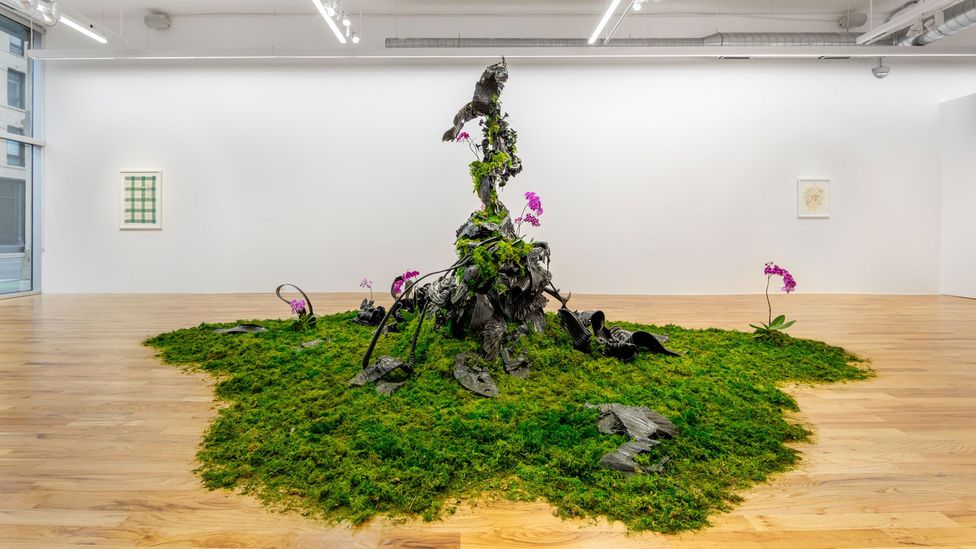
Monument by Regan Rosberg combines black plastic with moss and orchids to startling effect (Credit: Weinberg/Newton Gallery, Chicago, IL. Photography by Evan Jenkins)
Monument, the show’s centrepiece, created by Denver-based artist Regan Rosberg, is only one example of how artists can translate abstract-seeming scientific research into striking works that connect us viscerally with the climate changes we’re grappling with. “You walk in and see the beautiful sod and the orchids, and you smell the aroma of the forest, and then you realise those swirling pieces are plastic, so ugly and so beautiful at the same time,” says Bronson.
This quizzical kind of beauty is, in fact, part of Rosberg’s artistic strategy. “I try to hook people with beauty, first because it’s needed and second, it’s a way to engage people and keep them interested.” She additionally engages people with the rain scent she has created to diffuse through the gallery. “Scent is directly tied to memory,” she points out, and this particular scent is one that humans are particularly attuned to as part of our evolutionary make-up.
This scent that conjures both nature and memory helps evoke a sense of empathy, connection and wonder, she says. With their attention and their emotions thus captured, viewers then feel more comfortable delving deeper into the meanings behind the contradictions embedded in the piece. Rosberg explains that moss is a highly adaptive species that is 350 million years old. Orchids, too, are highly adaptive, its origins also dating back millions of years. They represent the many species that have evolved and survived over eons. “These are living things that can teach us to adapt and be resilient,” Rosberg says. But they are co-existing alongside this giant mass of plastic. “Often we use plastic for two seconds, but it can last for 1,000 years.”
Dual purpose
Enmeshing and entangling those materials together dramatises where we are now, she says: living in a world where dystopian fears can overwhelm our sense of hope, and paralyse our ability to act. Holding both the dystopian and hope at the same time can be scary, she acknowledges. What good art can do, though, is provide the perspective that allows us to recognise that resilience is possible and that we can act, and there are many ways to do so.
That is in fact one of the show’s main points, says its curator Cyndi Conn. “So much of the conversation now has the message that we’re beyond the point of saving. That’s the headline. But it’s not hopeless. We’re at a crossroads. The exhibit is very candid about how grave the situation is. But we also show the beauty and the resilience of the planet.”
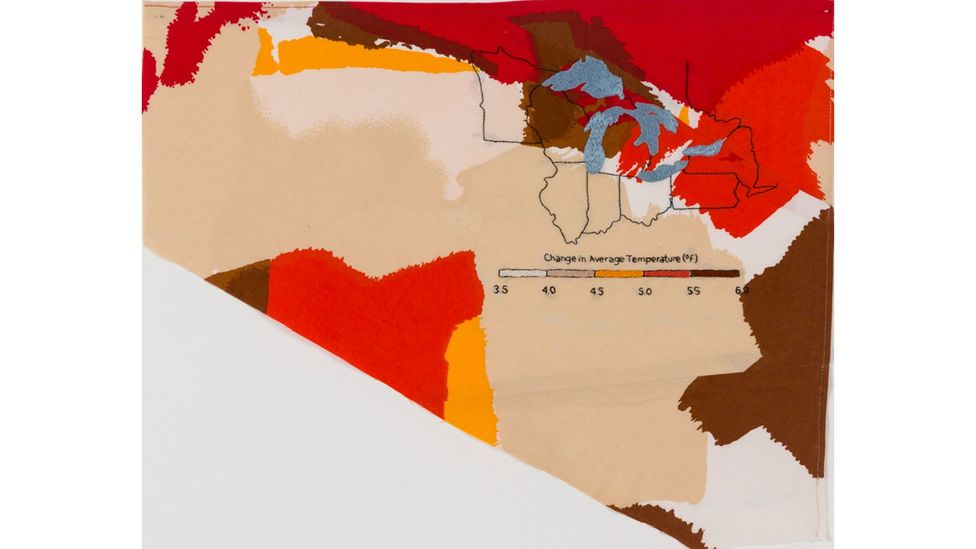
Karen Reimer uses textiles to create data visualisations showing the effects of climate change (Credit: Monique Meloche Gallery/Weinberg/Newton Gallery/ Photography: Evan Jenkins)
Strolling from one gallery room to the next, visitors encounter one artwork after another posing this duality, each in its own way. There are colourful, comfy-looking textured quilts by Chicago-based artist Karen Reimer that incorporate into their designs small-scale maps and graphs charting the extending reach of climate change. Reimer calls these “data visualisations” that both map – and make it easier to grasp – the impact of climate change. “We can’t look at a list of numbers giving daily temperatures for 100 years and understand it without a lot of mental process effort,” she said at an artists’ panel sponsored by the gallery (and available online), “but we can look at a line graph and see that continual rise in temperature much more quickly and easily.” Embedding the information within shimmering textiles allows visitors to approach and begin to digest the reality that scientific research can make dauntingly abstract.
Next up: delicate still-life watercolours by San Diego-based Laura Ball that depict entangled plants and animals engaged in – is it play, or is it an intricate dance of mutual destruction? Or perhaps their fight is based on adaptation as they evolve into an unknown future. “Most of the animals she incorporates are facing extinction. This is a reminder of the preciousness of biodiversity,” Conn says.
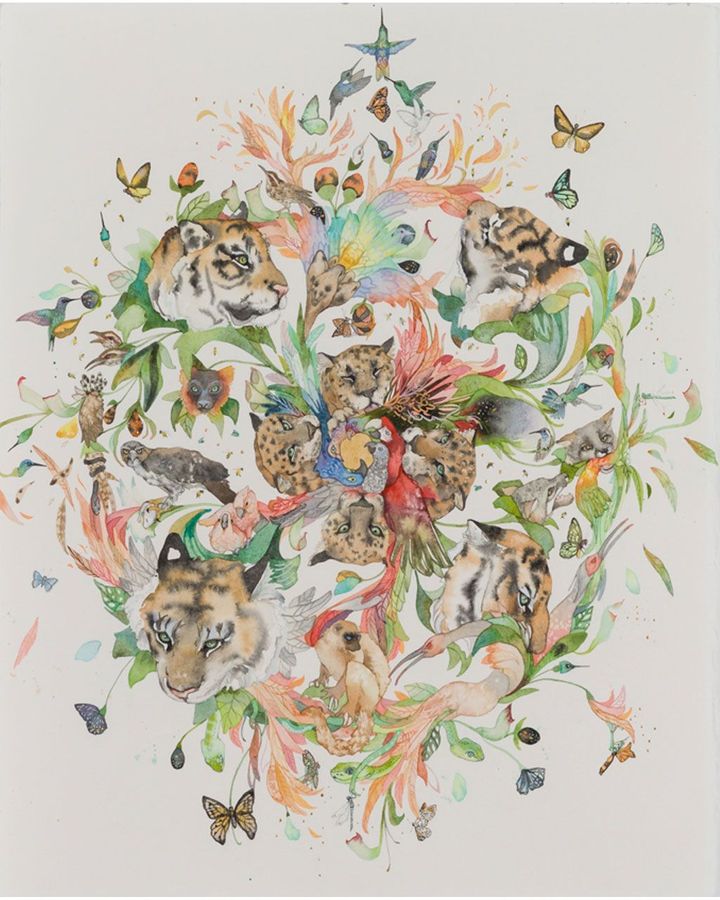
Laura Bell’s watercolours show endangered animals in the form of a ‘mandala’, or sacred symbol (Credit: Weinberg/Newton Gallery/ Photography by Evan Jenkins)
A continuous slide show presents powerful images taken by Donovan Quintero, a photojournalist for the Navajo Times (Diné bi Naaltsoos), documenting the dystopian-looking realities caused by drought, over-mining, wildfires and toxic waste dumps throughout the distressed lands of the Navajo Nation. The images seem surreal: the fire erupting like a distant volcano in the background of one photograph; then the mist of dust that enshrouds a riverbed; followed by a landscape of once-green land that is now a dried yellow-brown patchwork of cracks and creases. But the images depict reality, compelling us to confront how bias leads to a neglectful disregard that in turn amplifies the devastation of climate change on minority communities. Yet resilience resides in the images of the people who endure despite water shortages and lost grazing lands, and continue working to seek solutions.
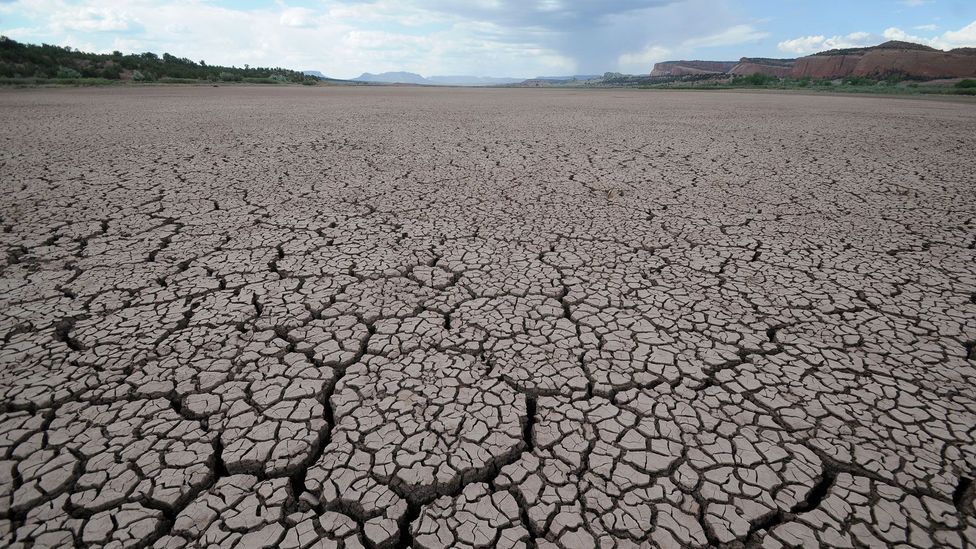
Donovan Quintero’s photos reveal the impacts of climate change on Navajo communities (Credit: Donovan Quintero/Weinberg/Newton Gallery)
The show also includes an inventive array of reimaginings of the Doomsday Clock: the iconic symbol created by the Bulletin of the Atomic Scientists to alert humanity to our unceasing countdown to catastrophe, as gauged by the concurrent threats posed by nuclear weapons, climate change, disruptive technologies and Covid-19. Its current setting in its countdown to oblivion: 100 seconds from midnight.
As re-envisioned by the French collective Obvious working with the Russian photographer Stas Barnikas, the clock now tracks climate change. Super-imposed on the clock is a continuously changing video montage. It is an amalgam of Barnikas’s photographs documenting the changes already wrought on the remote landscapes of the Arctic, further transformed through an artificial intelligence algorithm devised by Obvious, to provide a glimpse of the future that is at once eerily beautiful and devastatingly empty.
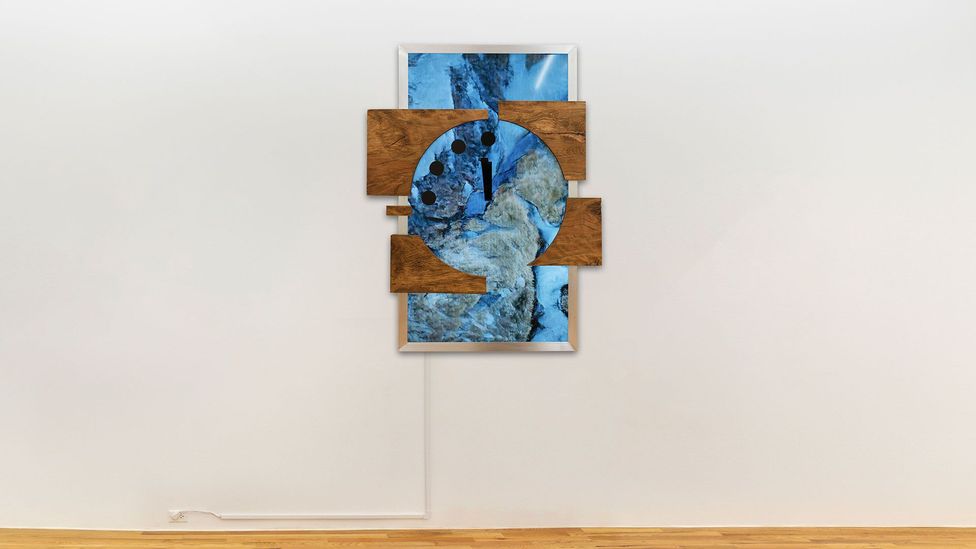
French art collective Obvious and Russian photographer Stas Barnikas have reimagined the Doomsday Clock (Credit: Weinberg/Newton Gallery/ Photography by Evan Jenkins)
New York-based artist Matthew Ritchie has created a three-part piece collectively called “This world, this garden, this time, or never again (Proposal for a world garden, a living clock)”. It begins with an eye-catching blue-yellow-green-brown watercolour map of the globe viewed as if from space, with 12 anchor-like arrows pointing around its clock-like shape at each hour of the clock to a ballooned caption that has scribbled within a possible action that could turn a potential “doomsday clock” into the “life clock” of the title. (An example: One o’clock is “Increase carbon-neutral power generation to meet current needs of wind and solar.”)
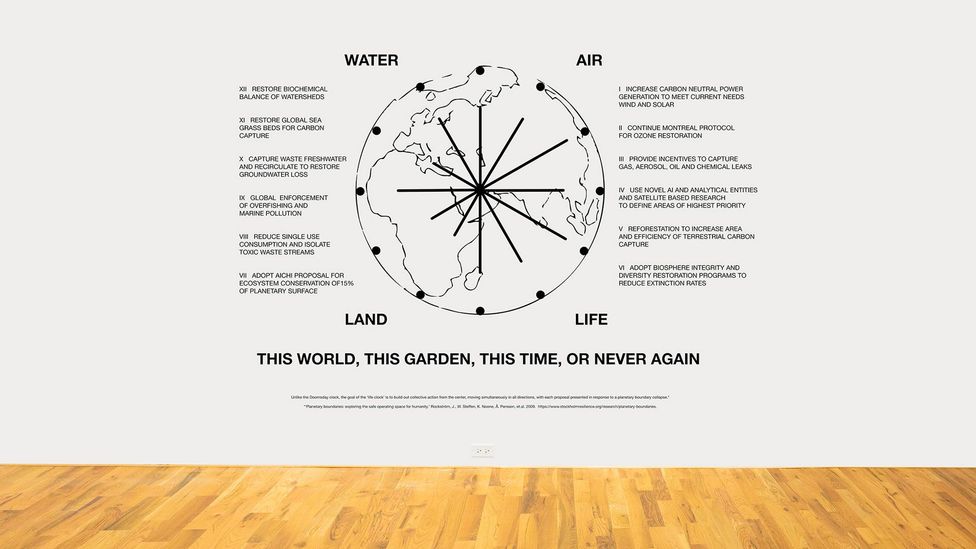
Matthew Ritchie’s version of the clock suggests collective actions that could be taken to tackle climate change (Credit: Weinberg/Newton Gallery/ Photography by Evan Jenkins)
The second piece is a sober black-and-white vinyl version containing the same information, this time clearly and boldly printed and impossible to mix. The caption reads: “Unlike the doomsday clock, the goal of the ‘life clock’ is to build out collective action from the centre, moving simultaneously in all directions, with each proposal presented in response to a planetary boundary collapse.” Finally, the third piece is a blank clock that invites viewers to add post-it notes suggesting their own ideas and suggestions for fighting climate change; it is now almost entirely covered with messages in response.
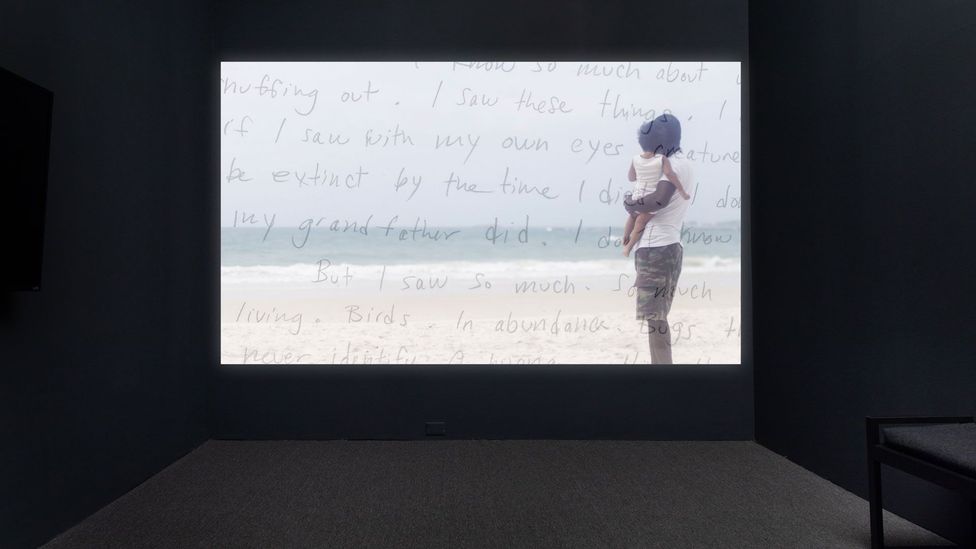
Rosberg’s Dear Future video features a range of ‘letters to the future’ (Credit: Weinberg/Newton Gallery/ Photography by Evan Jenkins)
Rosberg similarly invites viewers to engage and respond to her video Dear Future, also included in the show. It is a narrated selection of the more than 150 letters from artists, activists, scientists, biologists, children and teachers, among others, that she has gathered, with each letter addressing the way climate change has affected their views of the future. Readings from the letters, that range from the hopeful to the poignant to the tragic, are interspersed with photos Rosberg took documenting the environmental changes she saw during her artist’s residency in the Arctic. At the show’s conclusion, viewers are invited to sit at a nearby desk and write, by hand, their own letters to the future. Those who write a letter receive a small vial containing the scent Rosberg created for Monument. So many people have contributed their thoughts, Rosberg has been asked to provide more scent as the show continues.
Before visitors leave the exhibition, they are given the chance to write to their elected representatives. They can also pause and learn from ongoing videos featuring a range of scientists and others presenting, on a more personal level, what they are doing. By all measures, the show is getting its message across. Attendance numbers rose so high that the exhibition was extended by a month, and the responses to individual artworks keep growing. And the show is sparking conversation among those who visit. “I’ve been present when people start talking about how climate change is personally affecting them,” Khan-Giordano says.
But the realities facing us remain. “If we do nothing, we are in danger,” Bronson says. At the same time, she continues, “What we’re seeing on climate does give me optimism: you can see political parties globally responding… Even in the United States business community, you see a greater sense of urgency from 20 years ago… But we need to move faster.”
Can artists provide the inspiration for that push? “Art can be a punch in the gut,” says Conn. “But it does not have to be horrifying. It can also be inspiring. There is also a place for optimism. Because if we don’t have optimism, we won’t take action.”
Human/Nature is at the Weinberg/Newton Gallery in Chicago until 16 April.
If you would like to comment on this story or anything else you have seen on BBC Culture, head over to our Facebook page or message us on Twitter.
And if you liked this story, sign up for the weekly bbc.com features newsletter, called The Essential List. A handpicked selection of stories from BBC Future, Culture, Worklife and Travel, delivered to your inbox every Friday.
